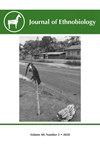祸根还是福气?回顾亚太地区蝙蝠的文化价值
IF 1.3
3区 社会学
Q1 ANTHROPOLOGY
引用次数: 22
摘要
摘要Chiropotophobia,或对蝙蝠的恐惧,包括对蝙蝠作为疾病媒介、害虫或与恶灵有关的有害生物的负面看法,是全球蝙蝠保护的一个重要障碍。它在很大程度上源于西方文化观念的影响,忽略了其他地区蝙蝠的多样文化观念,而这些文化观念在很大程度上将被忽视。为了更好地了解亚太地区当地对蝙蝠的信仰和文化认知,以及它们如何有助于设计基于文化的保护策略,我们对英语文献中记录蝙蝠在亚太传统中文化价值的出版物进行了审查。我们在该地区24个国家的60种不同文化中发现了119种蝙蝠文化价值,并发现了广泛的报告,我们根据五个野生动物价值类别对其进行了分类,并根据积极、中立和消极对这些价值进行了进一步分类。我们发现,62%的文化只有正值,8%只有中性值,而10%只有负值。这表明,与大多数西方社会相比,亚太地区及其文化与蝙蝠的联系要积极得多,因此,为促进人类与蝙蝠的共存提供了有希望的例子和机会。然而,我们也讨论了当地的信仰体系可能并不总是与日常实践或保护目标相一致。我们建议采用有针对性、基于文化和当地背景的外联策略,以便在亚太国家开展更有效的蝙蝠保护和教育。本文章由计算机程序翻译,如有差异,请以英文原文为准。
Bane or Blessing? Reviewing Cultural Values of Bats across the Asia-Pacific Region
Abstract. Chiroptophobia, or the fear of bats, which encompasses negative perceptions of bats as disease vectors, pests, or harmful creatures associated with evil spirits, represents an important barrier to bat conservation globally. Derived largely from the influence of Western cultural perceptions, it ignores the diverse cultural perceptions of bats from other regions, which have been largely overlooked. To better understand local beliefs and cultural perceptions regarding bats across the Asia-Pacific region, and how they may help design culturally grounded conservation strategies, we conducted a review of publications in the English-language literature documenting cultural value of bats in Asia-Pacific traditions. We discovered 119 bat cultural values in 60 different cultures from 24 countries across the region and found a wide spectrum of reports, which we categorized according to five wildlife value categories and further categorized these values according to positive, neutral, and negative. We found that 62% of the cultures had only positive values, 8% had only neutral values, while 10% had only negative values. This suggests that the Asia-Pacific region and its cultures contain far more positive associations with bats than most Western societies and, as such, offer promising examples and opportunities to promote human-bat coexistence. However, we also discuss how local belief systems may not always align with daily practices or conservation objectives. We suggest employing targeted, culturally grounded and locally contextualized outreach strategies in order to carry out more effective bat conservation and education in Asia-Pacific countries.
求助全文
通过发布文献求助,成功后即可免费获取论文全文。
去求助
来源期刊

Journal of Ethnobiology
Social Sciences-Anthropology
CiteScore
4.80
自引率
3.40%
发文量
21
审稿时长
>12 weeks
期刊介绍:
JoE’s readership is as wide and diverse as ethnobiology itself, with readers spanning from both the natural and social sciences. Not surprisingly, a glance at the papers published in the Journal reveals the depth and breadth of topics, extending from studies in archaeology and the origins of agriculture, to folk classification systems, to food composition, plants, birds, mammals, fungi and everything in between.
Research areas published in JoE include but are not limited to neo- and paleo-ethnobiology, zooarchaeology, ethnobotany, ethnozoology, ethnopharmacology, ethnoecology, linguistic ethnobiology, human paleoecology, and many other related fields of study within anthropology and biology, such as taxonomy, conservation biology, ethnography, political ecology, and cognitive and cultural anthropology.
JoE does not limit itself to a single perspective, approach or discipline, but seeks to represent the full spectrum and wide diversity of the field of ethnobiology, including cognitive, symbolic, linguistic, ecological, and economic aspects of human interactions with our living world. Articles that significantly advance ethnobiological theory and/or methodology are particularly welcome, as well as studies bridging across disciplines and knowledge systems. JoE does not publish uncontextualized data such as species lists; appropriate submissions must elaborate on the ethnobiological context of findings.
 求助内容:
求助内容: 应助结果提醒方式:
应助结果提醒方式:


